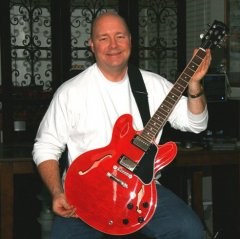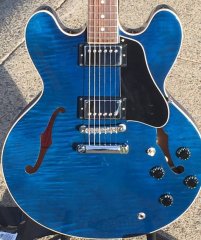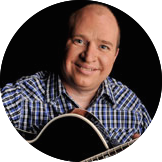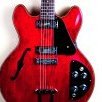BluzCruz
Members-
Posts
20 -
Joined
-
Last visited
Content Type
Profiles
Forums
Gallery
Events
Articles
Blogs
Downloads
Everything posted by BluzCruz
-
How to repair cracks in white nitro gibson finish
BluzCruz replied to BluzCruz's topic in Guitar Care, Repair & Building
It probably got dropped in transit but it didn't really have any "impact" marks on the case or the guitar, just the crack in the body. It could also just be that the wood just cracked as it dried out...maybe it wasn't fully aged or else maybe humidity changes caused it to dry further and crack. Anyway, I returned it and guitar center promptly relisted it as a brand new guitar with no suggestion of the issue. Someone somewhere bought it and I hope they are happy with it but even though I got a decent deal on it, there was no way I was going to keep it with that crack in the wood. Too bad, it was otherwise great. -
Playing in a Band? Post pic & videos
BluzCruz replied to Texaspackerfan's topic in Guitar Playing & Technique
And one more for some good clean fun. -
Playing in a Band? Post pic & videos
BluzCruz replied to Texaspackerfan's topic in Guitar Playing & Technique
It's an old post, but that's ok, I'm an old guy. And this is an old video from a few years ago but I ran this allman bros tribute band and we gigged a couple times a month for a few years. Fun stuff. I'm playing the SG. (Also, I solo at about 3:07 'cuz it's all about me! Just kidding. ) -
How to repair cracks in white nitro gibson finish
BluzCruz replied to BluzCruz's topic in Guitar Care, Repair & Building
Oh well. No replies. I took it to a luthier and also consulted a luthier's forum. Opinions varied. But my local luthier said he thought the wood was broken and I should return it. I took it home and took the backplate off, put a little pressure on it and I could see the crack separate slightly. Yup...broken wood. Returning it to guitar center. -
I just bought a 2018 (still brand new) Alpine White nitro Gibson SG. Unfortunately, it arrived with some finish cracking which I think is due to temp changes between Michigan (where it originated) and California. It's not in a very visible location, so I might keep the guitar because they are hard to find currently and I like it. But I'm concerned about these cracks spidering out or extending to the top surface of the guitar. It currently extends from the control cavity on the back, around the edge of the guitar, but not onto the top/front. Would a small brush with lacquer retarder or lacquer thinner melt the nitro finish back together and prevent further spreading of cracks? How cosmetically "clean" would that result be? invisible? visible but prevents future spreading of cracks? worse than leaving it alone? Is there a better approach? Frankly, I don't trust my local luthiers...every one I've tried over the years has done really boneheaded things...from putting a bridge in backwards, to setting up guitars with just bizzare adjustments due to a nut that was too low to start with...amateurish. I do most of my own work now but I haven't done any finish work. I wouldn't know who to trust and I certainly don't want to ship the guitar cross country again and risk more temperature based cracking. Any suggestions?
-
Another resource worth looking at is The Rock House Method Presents Fretboard Autopsy: Scales, Modes & Melodic Patterns Paperback & DVD by Rusty Cooley I like that it takes the G major scale and plays the modes as "three note per string" scales, and lays them out in very readable format of diagrams and tab. Spend a couple weeks on lesson 1. Maybe more. Steve covers TNPS scales somewhere along the way but I don't recall that he tied that to modes, even though that is what the seven patterns essentially are. Rusty lays out important characteristics and relationships. Worth a look. I haven't done the whole book, only the first "lesson" but I like the book and paging forward, I like where it is going. However, to understand modes - I'd still recommend resources 1 and especially 2 above in my original list.
-
IN ORDER: see these resources to understand modes 1) Signals Music Studios You tube video on Modes - parallel modes. Only 15 minutes and the absolute best summary. 2) Desi Serna's MODES DVD or Online course (also a module of his fretboard theory book 1) Not free, but the best thing to make the light bulb go on and provides numerous musical examples of modes -- which is ESSENTIAL to appreciating modes. I can't recommend this highly enough. It is ABSOLUTELY the best thing modes. It just isn't free. 3) Steve Stine - You tube modes videos (multiple) - just another viewpoint, but he's pretty good. I think his modes discussion still leaves gaps, but you can learn something from him too. 4) Pebber Brown - you tube modes discussion - Pebbler is terse and can be offputting. But watch his video anyway. In particular he flys over the concept quickly of parent scale modes verses parallel modes. It's really important to cutting through the confusion. Most instructors approach modes from parent scales, deriving them and that's great but...leaves confusion about how to apply it. You need to understand both. If you don't get modes after all that - you might have gaps in basic theory: building the major scale, building Triads for each note of the scale. Harmonizing the major scale. All concepts you can master in Learn and Master Guitar - and should. Modes sometimes get pigeon-holed as useless, or as some academic theory exercise. WRONG! They are very powerful for composers as a way to evoke specific emotions, or specific sounds similar to how a major scale sounds "bright and happy" and a minor scale sounds "dark and sad". In fact, the major and minor scales ARE two of the modes. In fact, if you understand modes well, you have a whole new toolbox for soloing. The application to soloing is this. Just as you might play a solo and move between major pentatonic and minor pentatonic scales in the same song, you can move between modes that have a common tonal center, in the same solo or song. This is powerful. It's how you can build solos that are interesting, instead of boring. A similar example common in blues music is to move between the Blues Scale (pentatonic with blue notes) and the Mixolydian mode. Resources 1 and 2 in the list above will help you HEAR the modes, and when you do, you'll understand their application immediately. 3 and 4 also are worth watching.
-
Old L&M site no longer accessible
BluzCruz replied to Wim VD1's topic in Learn & Master Course Questions
Thanks -
Old L&M site no longer accessible
BluzCruz replied to Wim VD1's topic in Learn & Master Course Questions
Anybody know how to get a digital copy (pdf) of the lesson book for Learn and Master Piano course? I was updating my archives and noticed I never downloaded that one. I know you used to be able to download the lesson books from the old site. -
I appreciate the recommendations, but I have to report back on these. I bought the JAPARTS and made 5 nuts with them. I found it very time consuming, and as I was working, destroyed a couple nuts because going from one file to the next, the cutting edges were so much different. Some sharp, some dull, including on the first nut when the files were all brand new. Overall, I thought it took what seemed like a really long time to cut the nut slots, but I was new to it so I wasn't sure. I kept thinking...how do the shops make any money on this, even at $80-$100? I decided to try a set of Stew-Mac files....wow...night and day difference. Much sharper and more consistent edges from file to file. They were cheaper and SO much better. I'm actually considering asking for my money back on the JAPARTs...I either got a bad set or they kinda suck. I'm going to assume I got some duds. But for $85, that shouldn't happen. What I did prefer on the JAPARTS files was: 1) They are sized to exactly match the string sizes in a set of strings 2) the file end corners are rounded to help prevent scratching anything. But all things considered, the Stewmac files were WAY better than the JAPARTS and cost less. I would recommend them over the JAPARTS in a heartbeat, now having used both. Just offering that up for anyone else who might be starting out and trying to figure out which nut files to buy....I'd go the stewmac route.
-
Thanks Dave. Very helpful. I also like that unlike StewMac and Grizzly - these guys were smart enough to assemble sets of files that correspond exactly to the typical string sizes in common string sets. I requested a quote and delivery timing.
-
Hi Greg, I was wondering if you have a recommendation on nut slot files. I see Stewmac has sets and individuals, and I've seen Grizzly nut files. These sets range from about $75 to $95 for 6 to 8 files, and around $15 each for individual files in other sizes. I just wondered what you use and if you have any recommendations of cheaper options that are still high precision? I'm taking the plunge and I'm going to try my hand at doing some nut work...something I have avoided for years. I do most of my own maintenance and setups but never tried cutting nut slot depth before. I decided it's time to start. Thanks!
-
Greg Voros; Answers Your Questions
BluzCruz replied to NeilES335's topic in Guitar Care, Repair & Building
<moved to new topic> -
If you're struggling to get faster, just keep doing the exercise every day, from the beginning and DON'T skip over the slow speeds. Those reps are important for building muscle memory, stretching, gaining control. Focus on playing extra clean at those slower speeds. Yes, it gets boring, but it won't be boring when you can shred. Listen to the tone of the picking, listen for other noise from other strings, etc. get your upstrokes and downstrokes to sound the same in volume and tone. Play it nice and clean, and slow. As you speed up, go as high in speed as you can play cleanly. When you hit the limit where it breaks down and starts to get sloppy, set your own metronome about 4-8 BPM slower and do the exericise at that speed for about 5 more minutes, without moving the speed up or down. If you do that every day, you'll find before long you'll gain a little more speed. You can also try to ladder up....back off 15-20 BPM and then step back up in small increments of 4 BPM or whatever you metronome can do and slowly you'll get to where you can go to new speeds. The other thing you can do that may help is simply to work on your right hand picking. It may be that you cannot even pick the strings at those faster tempos. Consider setting a 2 min timer and simply playing 16th notes on each open string for 2 min per string. Work up until you find your max tempo, if it's smooth, go up a little faster until you find where your right hand is breaking down. Then back off slightly and do it at that tempo for 2 min per string every day. within a few days, your right hand will get faster, and you may find the other exercise will pick up speed too. It helps to analyze what is slowing you down, if you can. Is it your right hand? your left hand? Finger flyaway? Is it the shifts in the chromatic scale exercise? The stretch notes in the "main" exercise? Once you know you can isolate what is slowing you down and do other things to improve that aspect. But mostly...just keep doing the exercise and be patient and it will eventually come. Once you have it, it doesn't fade too much.
-
That's ok it's not a competition, except against yourself. I only posted it because I made it for my own practice and thought others might find it useful. Do the reps and you'll get there too. Good luck
-
Since Steve didn't walk the huttlinger exercise up through the full metronome....here it is! From 8th notes at 100 BPM to 16th notes at 120 BPM. It takes only 10 minutes. So practice along every day until you get it. I was a bit sloppy at the end on this particular day. Mea Culpa. https://youtu.be/HfGr4zLoz3o
-
Guitar is so great and fun. But at first, it can be frustrating and painfully slow plodding. Don't lose faith...it will come to you with practice and before long you'll be playing songs! In session 3 you are just starting to try a couple chords. That's a big new thing for your fingers to learn to do. And your fingers right now are just plain weak and untrained. So follow the course materials, practice, and give your fingers time to learn. Here is the best method I've ever found for learning new chords efficiently (i.e. faster), and for learning to change between them. However, it does require that you are able to get the chord to ring out. So it may just be a little too strenuous for you at this point. You can try it for a day or two and see if it helps you get those chords burned into your muscle memory. At this point in your development you'll find it next to impossible to follow the chords he is playing and don't even TRY to form those yet - your fingers are not ready! But the methodology in this video is pure gold. He's also going a LOT faster than you should or probably could at this stage in your development. Good luck!
-
Do this 5 min a day, nice and slow, and concentrate on no finger fly-off. Again...nice and slow. Going fast is no help. Don't ladder up the speed. Just do it slow for 5 min in control. Not really new information here, just another perspective and presenter. Being in control is the goal. https://www.youtube.com/watch?annotation_id=annotation_801604117&feature=iv&src_vid=qQNaxGUB9fY&v=1Ok8lj6eJ78







